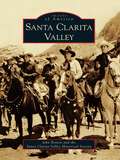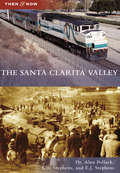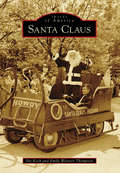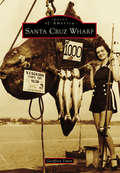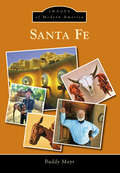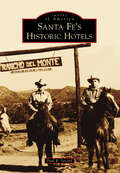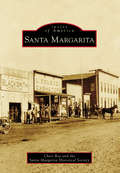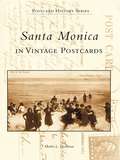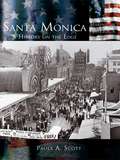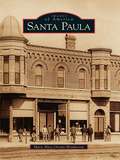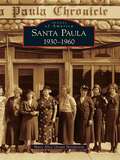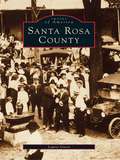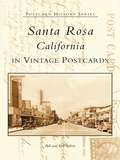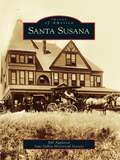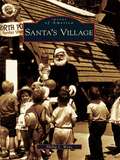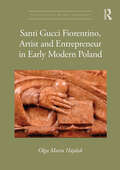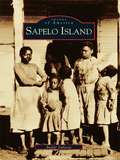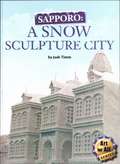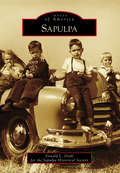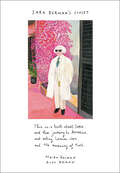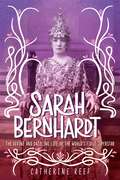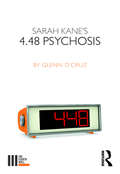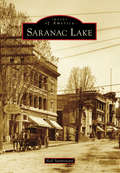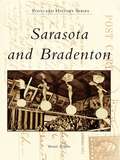- Table View
- List View
Santa Clarita Valley
by Santa Clarita Valley Historical Society John BostonA trade crossroads dating back to Native American times, Santa Clarita may be relatively new in the story of Los Angeles County's suburban sprawl, but old-timers also recall it as the "Navel of the Universe." A Chinese general once declared the Santa Clarita Valley one of the top 10 military targets on Earth. Located east of the Ventura County line where the valley creates a break in the Angeles National Forest, Santa Clarita has been home to cowboys, movie stars, farmers, and pistol fighters. With a diverse population of 250,000 today, the Santa Clarita Valley still boasts an eclectic heritage. The West's first major oil refinery is located here. The ground was bloodied by at least 21 deaths in one of America's last and greatest range wars. And local lore has maintained that the world's largest grizzly bear, weighing more than a ton, was shot here.
Santa Clarita Valley, The
by E. J. Stephens Dr Alan Pollack Kim StephensBorn in 1987 as the nation's first new city with a population greater than 100,000, Santa Clarita, California, has a fascinating history that stretches back to the rugged Wild West era. Hollywood recreates this history in Santa Clarita and its surrounding valley, to the delight of movie fans worldwide.
Santa Claus (Images of America)
by Pat Koch Emily ThompsonSanta Claus, Indiana, acquired its famous name in 1856 and has been celebrating the spirit of Christmas ever since. Postmaster James Martin began answering children's letters to Santa and his elves in 1914, a tradition that continues to this day and makes Santa Claus a favored destination for those seeking the holiday spirit. The town's unique name prompted Robert Ripley to feature it in his popular cartoon strip, and businessmen such as Carl Barrett and Milton Harris raced to erect Christmas attractions as early as 1935. Beating Walt Disney by nearly a decade, Louis J. Koch opened Santa Claus Land, the nation's first theme park, in 1946. Today, visitors still flock to Santa Claus to share in the magic of "America's Christmas Hometown."
Santa Cruz Wharf (Images of America)
by Geoffrey DunnFor a century now, the Santa Cruz Wharf has shone as one of the crown jewels of the Pacific Coast, and today it serves as a gateway to the Monterey Bay National Marine Sanctuary. What began as a shipping pier quickly morphed into the home of the colorful and fabled Santa Cruz Italian fishing colony. In its most recent iteration, the wharf serves as the primary destination for upward of four million annual visitors to Santa Cruz County. Since the time of the California Gold Rush in the late 1840s, there have been six wharves, or wooden piers, along the Santa Cruz waterfront, providing critical links for the local community to regional and global markets. The Santa Cruz Wharf, and all the 4,528 wooden piles that compose it, provides both external and internal vistas not found anywhere on land and is a place for contemplation, reflection, and quietude.
Santa Fe
by Buddy MaysLocated in the foothills of the Sangre de Cristo Mountains, Santa Fe was founded in 1608 by Spanish colonists and Franciscan missionaries who were searching for gold, arable land, and Indians to convert to Christianity. In the 400 years since, this mountain community has been the hub of Spanish colonialism in the New World, the terminus of the historic Santa Fe Trail, and since 1912, the state capital of New Mexico. It is America's third-oldest continuously inhabited, European-built community, surpassed in age only by St. Augustine, Florida, and Jamestown, Virginia. It is also the birthplace of Santa Fe style, a term used to describe the unique amalgamation of Indian, Spanish, and Anglo cultures that has strongly influenced the world of architecture and fashion since the 1960s and made the city one of America's most popular and recognizable tourist destinations.
Santa Fe's Historic Hotels
by Paul R. SecordIt is unknown when the earliest commercial lodging establishment came to Santa Fe. However, the first clear identification of a hotel at a specific site in Santa Fe dates to 1833, when Mary and James Donoho operated an inn on the site of what is now La Fonda on the Plaza, the Inn at the End of the Trail. This book presents an overview of Santa Fe hotels from the past and highlights the city's important remaining historic hotels. The chapters include key establishments that had their start in the early 20th century and continue in operation today. Most of them are still in buildings with considerable historic and architectural significance, such as Bishop's Lodge, La Fonda, and the St. Francis. A chapter on an iconic Route 66 motor court, which is now known as the lovingly preserved El Rey Inn, is also included.
Santa Margarita (Images of America)
by Santa Margarita Historical Society Cheri RoeSanta Margarita de Cortona was founded in 1775 as part of the original Spanish mission system. Its asistencia, in fact, has been considered a lost mission. Santa Margarita Ranch was later founded from a Mexican land grant. In 1889, the arrival of the Southern Pacific Railroad, with its terminus in Santa Margarita, created a boomtown with dance halls, blacksmiths, hotels, pool halls, saloons, and a jail. And with the popularity of auto travel half a century later, Santa Margarita was once again revitalized with garages, gas stations, motor inns, restaurants, and bars. It fell into a deep sleep, however, as Highway 101 bypassed the town in the mid-1950s. Landlocked by the 17,000-plus-acre Santa Margarita Ranch, the town has remained frozen in time until recently.
Santa Monica in Vintage Postcards (Postcard History Series)
by Marlin L. HeckmanSanta Monica was founded in 1875 and by 1887, the area was caught up in the real estate frenzy of the time with advertisements suggesting that it had "one of the grandest panoramic views the human eye has ever rested on . . . " In over 200 vintage postcards, here is Santa Monica in all its coastal splendor, including views of the bathing beaches, the Roosevelt Highway, and private citizens' beautiful Chinese Gardens.
Santa Monica: A History on the Edge
by Paula A. ScottAn icon of Southern California and one of America's most imaginative and vibrant cities--the fitting destination at the end of Route 66--Santa Monica lies on the brink of the West and is known throughout the nation for its beaches and its Hollywood A-list locals With a foundation built by the Gabrielino Indians and molded by Spanish and Mexican land grants, railroad battles, and a constant influx of settlers, Santa Monica became an oceanside haven for actors and airplane companies, road races and ranchers.
Santa Paula
by Mary Alice HendersonSanta Paula was built on the foundations of citrus cultivationand oil production. Ventura County's first irrigated 100-acreorange and lemon orchard was planted at Santa Paula in 1874, and the original 1888 harvest was so plentiful and delicious that the Limoneira Ranch Company was incorporated in 1893 and continues to thrive. Oil seeps brought wildcatters, and California's first gusher came in at Santa Paula in 1888. The town's twin notorieties through the 20th century were its designation as the "citrus capital of the world" and as the birthplace of the Union Oil Company of California (UNOCAL). Lemons and avocados remain the primary tree crops, the oil fields still produce, and the small-town character of bygone days has been preserved--Santa Paula has the largest concentration of vintage structures in the county.
Santa Paula: 1930-1960
by Mary Alice HendersonThis visual history of the 20th century's middle decades in Santa Paula illustrates how a rural city settled into its middle age. As a sequel to Images of America: Santa Paula, which covered the pioneering and settlement years of 1870 to 1930, it continues this Ventura County city's story through the Depression decade and the World War II and Korean War home front years that led up to the sixties. The time from 1930 to 1960 was prosperous for the two main industries in Santa Paula and its environs: citrus cultivation and oil production. The population increases reflected the job opportunities that these industries presented, bringing other families, businesses, and opportunities to the growing city.
Santa Rosa County
by Laurie GreenThe history of Santa Rosa County is closely associated with wood and water. Harvesting of the huge virgin pine trees that covered the area attracted industry and labor. Streams and rivers powered the machinery used to harvest the timber and also provided the means of transport. The sawmills, shipyards, turpentine stills, and related industriesmade Santa Rosa County the most industrialized county in Florida prior to the Civil War. After the war, the county rebuilt from the damage done not by raiding Yankee troops, but by retreating Confederates. The whine of the steam saw signaled the beginning of an era of great prosperity, an era that saw Milton build some of its most famous buildings and prominent businesses.
Santa Rosa, California in Vintage Postcards (Postcard History Series)
by Bob Voliva Kay VolivaFrom the first Rose Carnival in 1864, to the Great Earthquake in 1906, and the building of Highway 101, this book documents the history of Santa Rosa, illuminated in over 200 vintage postcards. Included are postcards of Luther Burbank, horticulturalist and local hero, as well as many views of Fourth Street as it changed and grew with the town.
Santa Susana
by Bill Appleton Simi Valley Historical SocietySanta Susana is one of three rural towns in Simi Valley that began at the turn of the 20th century. The town derives its name from the surrounding mountains, Sierra de Santa Susanna, and grew up alongside the railroad depot built by the Southern Pacific Company in 1903. The history of Santa Susana can be traced back to the Chumash Indian village of Ta'apu and a Spanish land grant, El Rancho Simi. The area was first surveyed by the Simi Valley Land and Water Company in 1887 for the sale of ranches. By the mid-1950s, Santa Susana had become a recognized agricultural center, noted for citrus and walnut production. Corriganville and Bottle Village are unique tourist destinations that originated near the Santa Susana Airport. In the surrounding mountains, quirky religious groups established communes away from the public with strange names and stories: Pisgah Grande, The Great Eleven Club, and WKFL Fountain of the World.
Santa's Village: Tales Of Summer Fun, Hijinx And Debauchery As Told By The People Who Worked There (Images of America)
by Phillip L. WenzSince 1959, Santa's Village in Dundee has entertained millions. The park was born of a man who as a child had no real Christmas. Glenn Holland grew up in California during the Great Depression. His parents died by the time he was 18 years old, leaving him to care for his younger sister. As a father, he tried to give his own children the type of Christmas that he only knew in his dreams. In the early 1950s, struck with inspiration, Holland sat at his kitchen table one day and started to sketch his idea for a Christmas fairyland where all the magic of the holiday would come to life: Santa's Village. Holland and general contractor Putnam Henck builtthree Santa's Villages, two in California and one in Dundee.
Santi Gucci Fiorentino, Artist and Entrepreneur in Early Modern Poland (ISSN)
by Olga Maria HajdukThe original research in this book analyzes the artistic activity of Santi Gucci (1533– c.1600), a Florentine sculptor active in Poland in the second half of the sixteenth century, and his workshop.Chapters examine the organization of the artistic workshop (sculpting and masonry) and the model of the artist’s functioning as an entrepreneur in Renaissance Poland, using Santi Gucci’s activity as an example. Gucci shaped the image of Polish sculpture in the sixteenth century for more than 50 years, even though his work has not yet been fully examined. The author sets Gucci’s emigration within the context of the cultural exchanges between Italy and Poland that contributed to the development of the Polish Renaissance.The book will be of interest to scholars working in art history, Renaissance studies, architectural history and economic history.
Sapelo Island: People And Place On A Georgia Sea Island (Images of America)
by Buddy SullivanThe barrier islands of the south Atlantic coastline have for years held a deep attraction for all who have come into contact with them. Few, however, can compare with the mystique of Sapelo Island, Georgia. This unique semitropical paradise evokes a time long forgotten, when antebellum cotton plantations dominated her landscape, all worked by hundreds of black slaves, the descendants of whom have lived in quiet solitude on the island for generations. For more than 50 years of the twentieth century, two millionaires held sway on Sapelo, and it is their story, interwoven with that of the island's residents, that unfolds within the pages of this book. Almost 200 photographs provide testimony to the dynamic forces and energies implanted upon Sapelo by two men, Howard E. Coffin, a Detroit automotive pioneer, and Richard J. Reynolds Jr., heir to a huge North Carolina tobacco fortune. Beginning with a photographic essay about Sapelo's antebellum plantation owner, Thomas Spalding, Sapelo Island moves into the primary focus of the story, the years from 1912 to 1964, an era of grandeur that has left a rich photographic legacy.
Sapporo: A Snow Sculpture City (Fountas & Pinnell LLI Gold #Level Q)
by Josh Timm<p>Freezing Fun <p>In northern Japan, the month of February is bleak--freezing, dark, and piled with snow. But one city has figured out a way to turn a dreary month into something magical. Every year, the city of Sapporo hosts a snow festival, which turns the city into a fantasyland, filled with huge snow sculptures, delicate ice statues, and warm friendships. <p> <p>Text Elements: <li>Genre: Nonfiction, Expository <li>Text Structures: Main: Categorical, Embedded: Temporal Sequence, Cause/Effect, Description <li>Text Features: table of contents, headings, photos, captions, labels, sidebars</li> </p>
Sapulpa (Images of America)
by Donald L. Diehl for the Sapulpa Historical SocietySapulpa is named after a young Creek Indian who came to the area around 1840 and opened a trading post near Pole Cat Creek. Sapulpa’s arrival in Indian Territory was independent of the famed “Trail of Tears,” a term used for the federal government’s forced removal of Creek (Muskogee) and other tribes from their southern homelands in the 1830s. The area that would become the Creek Nation is a small part of the land acquired by the United States after the Louisiana Purchase in 1803. At one time, Spain, England, and France each laid claim to Oklahoma. Trails, rails, and oil; bricks, clay, and glass; and streetcars, highways, and automobiles are all parts of the historic community of Sapulpa. The diverse people who came to the area—Indians, cowboys, railroaders, settlers, loggers, farmers, wildcatters, oilmen, businessmen, manufacturers, workers, and dreamers—recorded the town’s story, as captured in photographs, beginning more than a century ago. Sapulpa was and remains a crossroads in more ways than one.
Sara Berman's Closet
by Maira Kalman Alex KalmanMaira Kalman, the author of the bestsellers The Principles of Uncertainty and The Elements of Style, and Alex Kalman, the designer, curator, writer, and founder of Mmuseumm, combine their talents in this captivating family memoir, a creative blend of narrative and striking visuals that is a paean to an exceptional woman and a celebration of individuality, personal expression, and the art of living authentically.In the early 1950s, Jewish émigré Sara Berman arrived in the Bronx with her husband and two young daughters When the children were grown, she and her husband returned to Israel, but Sara did not stay for long. In the late 1960s, at age sixty, she left her husband after thirty-eight years of marriage. One night, she packed a single suitcase and returned alone to New York City, moving intoa studio apartment in Greenwich Village near her family. In her new home, Sara began discovering new things and establishing new rituals, from watching Jeopardy each night at 7:00 to eating pizza at the Museum of Modern Art’s cafeteria every Wednesday. She also began discarding the unnecessary, according to the Kalmans: "in a burst of personal expression, she decided to wear only white." Sara kept her belongings in an extraordinarily clean and organized closet. Filled with elegant, minimalist, heavily starched, impeccably pressed and folded all-white clothing, including socks and undergarments, as well as carefully selected objects—from a potato grater to her signature perfume, Chanel No.19—the space was sublime. Upon her death in 2004, her family decided to preserve its pristine contents, hoping to find a way to exhibit them one day.In 2015, the Mmuseumm, a new type of museum located in a series of unexpected locations founded and curated by Sara’s grandson, Alex Kalman, recreated the space in a popular exhibit—Sara Berman's Closet—in Tribeca. The installation eventually moved to the Metropolitan Museum of Art, and in spring 2019, will become an outdoor monument to independence at the National Museum of American Jewish History on Independence Mall in Philadelphia.Inspired by the exhibit, this spectacular illustrated memoir, packed with family photographs, exclusive images, and Maira Kalman's distinctive paintings, is an ode to Sara’s life, freedom, and re-invention. Sara Berman’s Closet is an indelible portrait of the human experience—overcoming hardship, taking risks, experiencing joy, enduring loss. It is also a reminder of the significance of the seemingly insignificant moments in our lives—the moments we take for granted that may turn out to be the sweetest. Filled with a daughter and grandson’s wry and touching observations conveyed in Maira’s signature script, Sara Berman’s Closest is a beautiful, loving tribute to one woman’s indomitable spirit.
Sarah Bernhardt: The Divine and Dazzling Life of the World's First Superstar
by Catherine ReefA tantalizing biography for teens on Sarah Bernhardt, the first international celebrity and one of the greatest actors of all time, who lived a highly unconventional, utterly fascinating life. Illustrated with more than sixty-five photos of Bernhardt on stage, in film, and in real life. Sarah Bernhardt was a French stage actor who became a global superstar in the late nineteenth century—the Lady Gaga of her day—and is still considered to be one of the greatest performers of all time. This fast-paced account of her life, filled with provocative detail, brilliantly follows the transformation of a girl of humble origins, born to a courtesan, into a fabulously talented, wealthy, and beloved icon. Not only was her acting trajectory remarkable, but her personal life was filled with jaw-dropping exploits, and she was extravagantly eccentric, living with a series of exotic animals and sleeping in a coffin. She grew to be deeply admired around the world, despite her unabashed and public promiscuity at a time when convention was king; she slept with each of her leading men and proudly raised a son without a husband. A fascinating and fast-paced deep dive into the world of the divine Sarah. Illustrated with more than sixty-five photos of Bernhardt on stage, in film, and in real life.
Sarah Kane's 4.48 Psychosis (The Fourth Wall)
by Glenn D'Cruz"Everything passes/Everything perishes/Everything palls" – 4.48 Psychosis <P><P> How on earth do you award aesthetic points to a 75-minute suicide note? The question comes from a review of 4.48 Psychosis’ inaugural production, the year after Sarah Kane took her own life, but this book explores the ways in which it misses the point. Kane’s final play is much more than a bizarre farewell to mortality. It’s a work best understood by approaching it first and foremost as theatre – as a singular component in a theatrical assemblage of bodies, voices, light and energy. The play finds an unexpectedly close fit in the established traditions of modern drama and the practices of postdramatic theatre. <P><P> Glenn D’Cruz explores this theatrical angle through a number of exemplary professional and student productions with a focus on the staging of the play by the Belarus Free Theatre (2005) and Melbourne’s Red Stitch Theatre (2007).
Sarah Style
by Sarah RichardsonIn the flawless style of Deborah Needleman's Domino comes the interior design book of the decade, from HGTV star, virtual sensation, and Canadian design queen Sarah Richardson.Ever wondered how to transform your laundry room from drab to fab? Your kitchen from prison to paradise? Your bedroom from boring to beautiful? Now you can, in this comprehensive interior design tome by design maven extraordinaire Sarah Richardson. Within these beautiful, full-color pages and photographs, Sarah walks you through each room in your home, from the master bedroom to the kids' rooms, to the kitchen, the bathroom, and everywhere in between, showing you how to turn a house into a home--Sarah style. Featuring full-page design spreads with stunning attention to detail, Sarah Style is a cache of creative, unique ideas for transforming your living spaces. You can make your dream home a reality, and the inspiration--and complete know-how--is right here in this premier source for all things interior design!
Saranac Lake
by Neil SurprenantThe first settlers came to Saranac Lake beginning in 1819 to make a living from the forests of the Adirondacks. In the 1870s, wealthy city dwellers discovered the hunting, fishing, boating, and hiking available in these beautiful mountains, and Saranac Lake became the hub for local tourism. By 1900, Dr. Edward Livingston Trudeau had established the fresh-air cure for tuberculosis, and Saranac Lake became America's "Pioneer Health Resort." A culture of excellent medical facilities, an active arts scene, and a great library and educational system combined with traditional Adirondack values to make Saranac Lake "the Little City of the Adirondacks," a special place to everyone who got to know it. Later in the 20th century, the focus shifted from health to scientific research, education, state government offices, and the more middle class tourist industry of the post-World War II era. This designated All-America City has retained that special character.
Sarasota and Bradenton
by Bonnie WilponFrom the 1890s through the 1920s, the postcard was an extraordinarily popular means of communication, and many of the postcards produced during this "golden age" can today be considered works of art. Postcard photographers traveled the length and breadth of the nation snapping photographs of busy street scenes, documenting local landmarks, andassembling crowds of local children only too happy to pose for a picture. These images, printed as postcards and sold in general stores across thecountry, survive as telling reminders of an important era in America's history. This fascinating new history of Sarasota and Bradenton, Florida,showcases more than two hundred of the best postcards available.
